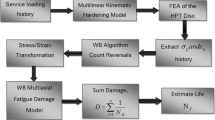The paper considers procedures for predicting safe damage to compressor and turbine disks in stationary and aircraft gas turbine engines at the stage of subcritical crack growth. The methods are proposed to evaluate inspection intervals and amounts of routine maintenance with consideration of the regularities underlying this type of crack growth. In this case, the features in the operation of materials are taken into consideration for stationary (peaking, semi-peaking, and steady-state modes) and aircraft (typical flight cycles) gas turbine engines. The crack propagation near various stress concentrators is analyzed with the help of the developed program using a stationary gas turbine disk as an example, which allows one to predict the crack growth life of the disk and the most probable location of its failure.





Similar content being viewed by others
References
N. D. Kuznetsov, “Assurance of reliability of engines for civil aviation,” in: Main Problems in the Theory and Practice of Reliability [in Russian], Sov. Radio, Moscow (1975), pp. 27–42.
B. G. Nesterenkî, “Development of regulatory requirements for fatigue and survivability of civil transport aircraft,” Probl. Mashinostr. Nadezhn. Mashin, No. 6, 117–126 (2010).
V. O. Bauer, V. K. Kuevda, G. V. Mel’nikova, et al., “Currently available approaches to the strengthening reliability verification in the certification of aircraft gas turbine engines,” in: Dynamics, Strength, and Life of Machines and Structures [in Russian], Vol. 1, Pisarenko Institute of Problems of Strength, National Academy of Sciences of Ukraine, Kiev (2005).
S. B. Kulishov, Prediction of the Life of Crack Growth to Critical Sizes in Heat-Resistant Steel EP517-Sh under Combined Action of Fatigue and Creep [in Ukrainian], Author’s Abstract of the Candidate Degree Thesis (Tech. Sci.), Kyiv (2010).
V. V. Pokrovskii, V. N. Ezhov, V. G. Sidyachenko, et al., “Crack resistance characteristics study results for 12Cr–2Ni–Mo steel,” Strength Mater., 44, No. 1, 59–63 (2012).
V. V. Pokrovskii, V. N. Ezhov, and V. G. Sidyachenko, “Effect of biaxial loading on the crack resistance characteristics of 12Cr–2Ni–Mo steel,” Strength Mater., 45, No. 3, 324–328 (2013).
V. V. Pokrovskii, V. T. Troshchenko, V. I. Tseitlin, et al., “Estimating working life for aircraft gas turbine engine disks at the stage of fatigue crack development. Part 2,” Strength Mater., 26, No. 12, 861–871 (1994).
RD 50-345-82. Methodical Guidelines. Strength Analysis and Testing. Methods of Mechanical Testing of Metals. Determination of Fracture Toughness Characteristics under Cyclic Loading [in Russian], Izd. Standartov, Moscow (1983).
S. M. Stepanenko, “On the strength of GTE disks with consideration of the fatigue crack propagation stage,” in: Proc. Int. Sci.-Techn. Conf. “Improvements in Turbine Installations Using Mathematical and Physical Modeling Techniques” [in Russian], Kharkov (1997), pp. 537–539.
S. M. Stepanenko, “Assessment of the strength of gas turbine engine disks with consideration of crack growth resistance,” in: Abstracts of Papers, XXVII Int. Sci.-Techn. Meeting on the Problems of Engine Strength [in Russian], IMASh–TsIAM–MAMI, Moscow (1999), pp. 54–56.
K. B. Yoon, A. Saxena, and P. K. Liaw, “Characterization of creep-fatigue behavior under trapezoidal waveshape using Ct -parameter,” Int. J. Fract., 59, No. 2, 95–114 (1993).
A. Saxena, R. S. Williams, and T. T. Shih, “A model for representing and predicting the influence of hold time on fatigue crack growth behavior at elevated temperature,” in: Fracture Mechanics: Thirteenth Conference, ASTM STP 743 (1981), pp. 86–99.
V. V. Pokrovskii, V. N. Ezhov, S. B. Kulishov, et al., “Influence of the modes of operation and structural factors on the crack propagation in 12Cr–2Ni–Mo steel,” Strength Mater., 41, No. 3, 285–293 (2009).
Author information
Authors and Affiliations
Additional information
Translated from Problemy Prochnosti, No. 3, pp. 89 – 98, May – June, 2016.
Rights and permissions
About this article
Cite this article
Pokrovskii, V.V., Sidyachenko, V.G., Ezhov, V.N. et al. Basics of Operation of GTE Disks by the Technical Condition: the Way to Extend Their Design Service Life. Strength Mater 48, 411–418 (2016). https://doi.org/10.1007/s11223-016-9779-7
Received:
Published:
Issue Date:
DOI: https://doi.org/10.1007/s11223-016-9779-7



